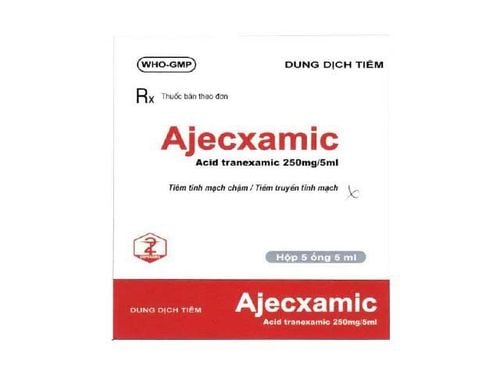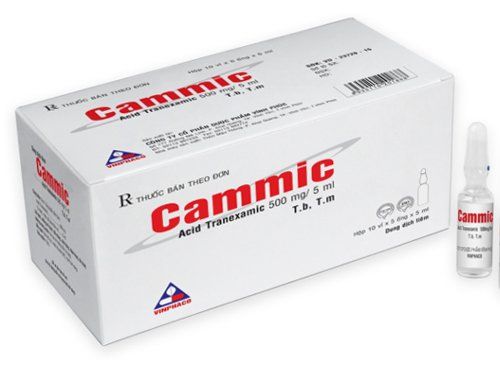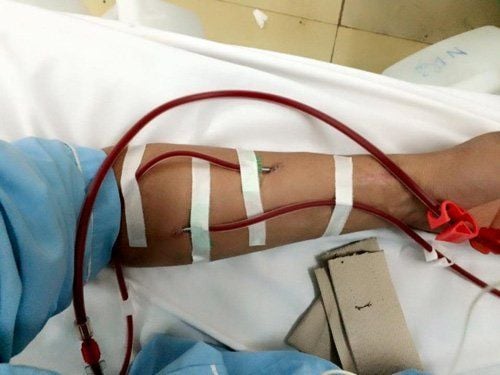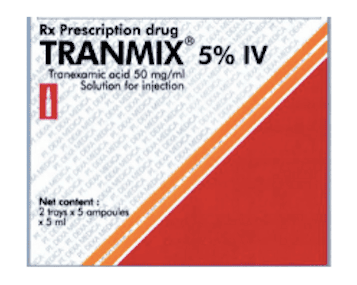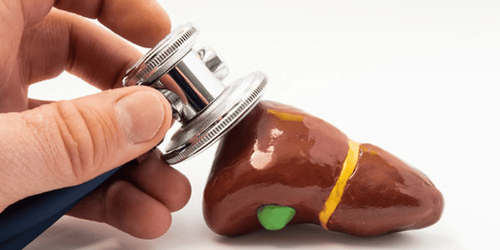This is an automatically translated article.
Broken nose blood vessels is one of the common conditions, due to many causes such as: high blood pressure, low air humidity, deviated nasal septum, side effects of some drugs,... In this situation, the patient needs first aid or emergency treatment right away.
1. Characteristics of blood vessels in the nose The nasal mucosa has the function of warming and humidifying the air thanks to a dense network of capillaries. The capillaries in the nose are so shallow that even a minor injury can cause bleeding. When bleeding can be violent (broken artery branches) endanger the patient's life if not treated promptly.
2. Causes of Broken Nasal Blood Vessels Nasal artery rupture is a condition in which tiny blood vessels in the arteries in the nose burst, leading to nosebleeds (nosebleeds). Because the blood vessels in the nose are so small, sometimes even a light touch, blowing your nose can lead to a nosebleed.
There are many causes for a person to have a broken nose blood vessel. Specifically:
Complications of high blood pressure: When blood pressure rises suddenly, it will increase pressure on the walls of blood vessels. High pressure to a certain extent can cause damage, rupture the nasal vessel wall, cause heavy bleeding and difficult to stop bleeding. Frequent nosebleeds will reflect how dangerous high blood pressure is; Low humidity: When you are in an environment with dry air, the lining of the nose is easily stretched, easily damaged, and causes nosebleeds; Abuse of decongestant sprays: When the nose is blocked, many patients tend to use decongestant sprays to make breathing easier. However, nasal discharge due to mucosal irritation, combined with excessive blowing of the nose can tear tissue, causing nosebleeds; Side effects of some drugs: Anticoagulants, steroids, and aspirin can affect the blood's ability to clot, causing nosebleeds. If there is a nosebleed after taking the above drugs, the patient should immediately notify the doctor; Injuries: stab wounds, work accidents, bullets, traffic accidents,...; Deviated nasal septum: If the surface of the nasal septum is dry, combined with the deviated factor of the nasal septum, this is an opportunity for foreign agents to easily enter the nasal cavity, causing infection and nose bleeding; Inflammation: Acute rhinosinusitis or allergic rhinitis; Tumor: Nasal cavity tumor, capillary tumor, ethmoid cancer, nasopharyngeal cancer; Other diseases: Acute myeloid leukemia, myelosuppression, dengue fever, chronic liver and kidney failure,... Other causes: Foreign bodies entering the nose, vascular malformations, aneurysms, inhalation of toxic chemicals (heavy metals, acids,...).

Vỡ mạch máu mũi là tình trạng vỡ các mạch máu nhỏ li ti trong động mạch ở mũi
3. Emergency treatment for broken nose blood vessels When a patient is having a nosebleed, the first thing to do is to stop the bleeding immediately and then find the cause of the disease. Detailed instructions are as follows:
3.1 In case of little bleeding Use 2 fingers to squeeze the nostrils; Use a vasoconstrictor wick such as ephedrine or antipyrine 20%, tightly inserted into the nasal cavity and vestibule; Burn with silver nitrate or electric cote. 3.2 In case of heavy bleeding Method to place the nose meche first:
Prepare tools: clar light, tongue pressure, nose opener, elbow fork, wick 40cm long - 1.5cm wide, gloved fingers; Medicines: Paraffin oil, 6% cocaine anesthetic and rubber capo bags; Implementation: Ask the patient to blow all the blood in the nose, put a 10cm long cocaine wick into the nose to relieve pain and vasoconstriction. After 3 minutes, take out the wick, use the nose opener to widen the nostrils, look in the nasal cavity for crest septum or deviated septum. Inject antibiotic ointment or paraffin oil into the posterior nasal cavity, insert a rubber bag to open the nose, and place the rubber bag in the nose. Next, use an elbow fork to insert the wick into the nasal cavity through the opening of the nose to a depth of 6-8cm, insert the wick into the nasal cavity close to the back of the nose from the inside out to the nose. While inserting the nose wick, it needs to be tight, not letting the gap die. Check the back of the throat, there is no blood flowing down the throat. Withdraw the wick: Do not leave the wick in the nose for more than 48 hours, usually withdraw it if there is a fever. When removing the wick, it must be withdrawn slowly, the patient's position is on his side, the doctor pulls the wick out slowly, one by one, each segment is no more than 5cm, every time stops for 5 minutes, while withdrawing the wick and adding hydrogen peroxide. nose. The wicking process takes 20-30 minutes. Method of placing the posterior nasal mask: Apply when nosebleeds are caused by damage to the posterior and upper nasal cavity or the anterior nose mask has been placed but it is not effective:
Prepare equipment: clar light, tongue pressure, nose opener, elbow fork, wick 40cm long - 1.5cm wide, gloved finger, small rubber Nelaton tube, cylindrical gauze 3cm high tied to a thread 25cm long, cylindrical gauze 1cm diameter; Implementation: Insert the Nelaton tube into the bleeding side nostril, push the tube down the pharynx. Ask the patient to open their mouth, and use forceps to pull Nelaton's head out of the mouth. Tie one end of the gauze to the tip of the Nelaton tube, pulling the Nelaton tube backwards from the throat to the nose. The gauze will be pulled back by the gums from the pharynx to the nasopharynx, plugging into the posterior nasal passage. When passing through the isthmus, the gauze is often entangled. At this point, the doctor needs to use the small finger of the right hand to push the gauze up and behind so that it passes through the narrow waist. The doctor's left hand holds the Nelaton tube and the thread is pulled forward. When done, cut the thread from the rubber tube, tie it to the 2nd gauze. This gauze seals the front nostril; After placing the posterior nasal meche, an anterior nasal meche can be added as described above. If the posterior and anterior nasopharynx have been inserted and the nose is still bleeding, the doctor may need to tie the internal maxillary artery in the fossa of the mandibular fossa or perform ligation of the anterior and posterior ethmoid arteries at the medial margin of the orbit.

Xây dựng một chế độ ăn uống khoa học để phòng ngừa vỡ mạch máu mũi
3.3 Use of drugs Transfusion, blood transfusion; Hemostatic drugs: Vitamin C, vitamin K, CaCl2, transamin, hemocaprol; Heart drugs: Spartain, ouabain,...; Painkillers: Alaxan, profenid,...; Strong broad-spectrum antibiotics: Third generation Cephalosporins; Sedatives: Gardenal, seduxen, rotunda, stilnox,... 4. How to prevent broken nasal blood vessels? Depending on the cause of the rupture of a blood vessel in the nose, each person will take corresponding precautions. Some tips include:
Build a scientific diet, supplement good foods for people with high blood pressure such as raisins, green vegetables, celery, fruits, oats,... Patients should spend more time to rest, relax, get enough sleep, do appropriate exercise to better control blood pressure; Do not pick your nose or put a foreign object in your nose. Avoid blowing your nose too hard. If you often have allergies, you should consult a doctor for treatment indications; Use an air humidifier in the dry season to ensure that the nasal mucosa does not dry out, causing damage to the capillaries in the nose; Regular health check-up, thorough treatment of related diseases in the nose, sinuses, throat, etc. When a nose blood vessel ruptures, the patient should be given first aid immediately and taken to the hospital if the bleeding is heavy and difficult to control. blood. At the same time, each person needs to pay attention to take care of their own health to minimize the risk of diseases that cause broken nose vessels and nosebleeds.
The Emergency Department of Vinmec International General Hospital operates 24/24 on all days of the week, including Saturday and Sunday as well as holidays of the year. The team of emergency doctors and nurses at the Department are professionally and thoroughly trained, able to receive and handle urgent cases of patients, and always coordinate with all specialties in a timely manner. fast.
With modern equipment and a team of experienced doctors, the Emergency Department has conducted emergency and saved the lives of serious and complicated patients. At the same time, patients at the Emergency Department are always coordinated care by many other specialized specialties (Team Base Care). Therefore, at the Emergency Department, patients will be examined, diagnosed, accurately and quickly, with high reliability and intensive treatment right from the emergency stage to help them quickly get out of the critical stage. dramatic and stable.
Please dial HOTLINE for more information or register for an appointment HERE. Download MyVinmec app to make appointments faster and to manage your bookings easily.




